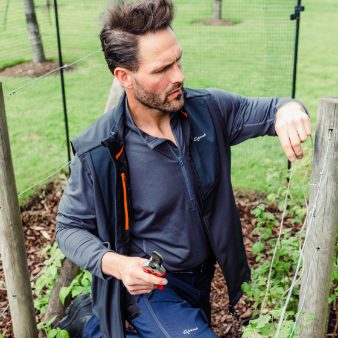Leaping into February

I like to think of February as the month that leads us from winter into early spring. With breathtaking sunrises followed by the lengthening days.. an absolute joy if you’re not an early riser like me! Throughout the month, I take great delight in watching the sea of snowdrops gradually carpet and brighten up sections of our woodland, with their pure white nodding flowers.
I’ve usually tackled most of the smaller jobs in the house Garden by now, and have moved on to the bigger jobs inside the Walled Garden. There’s lots of rose pruning still to do, and soil preparation ready for spring.
Provided we don’t get any heavy frosts or snow, weeding starts to become a priority. Thankfully it’s a job I enjoy doing and I can’t stress to you enough how important it is to get ahead of the game! I remember a gardening friend of mine said to me once if you can get on top of all your weeding before Easter, it will save you hours through the summer. You can imagine how that pecks away at my head throughout February and March until I’m done.
If you read last month's blog, you’ll already know that I now have a shiny new whiteboard, which is filled with gardening jobs that need to be done this month and next month, until we open our garden for the NGS on 27th and 28th April. I cannot begin to tell you the sense of achievement I get when we tick a job off the list. It’s such a good feeling. Are you a planner? .. and do you find making weekly/monthly lists useful when it comes to planning little jobs in your garden?
Here’s what’s on our list this month, clean and sharpened secateurs at the ready!
1-Pruning shrub and ground cover roses
2-Mulching the rose beds and borders
3-Pruning wisteria
4-Pruning kiwi
5-Cut back leaves from Epimediums
1- It wasn’t until we moved here and planted lots of roses that I began to understand the importance of not being afraid to prune them now. This is why we try to have all our shrub and ground cover roses pruned, some by a third, others to a half or more. Remove any dead, dying and diseased wood, also remove any stems that are crossing one another, keeping mindful to form a nice rounded open shape. Doing this keeps them healthy and encourages better blooms on strong stems.
2- Our rose beds in front of the old greenhouse are underplanted with alliums, and are framed with clipped box. As early as February the alliums can start pushing up their green shoots. in order to avoid flattening them, we clear the area of weeds, then rake up as many fallen rose leaves as possible to prevent any disease spores forming. Only then do I start mulching around the whole area including underneath the box hedges. We use a bulk load of spring mix from a local supplier, this acts as a brilliant top layer, weed suppressant and moisture lock.
3- We planted our wisteria against a curved south west facing wall near the house about fifteen years ago. It gets pruned twice a year, once in January or February, where we cut it back to two to three buds. The second pruning is in July or August, which is normally after it has finished flowering. More on that in July!
4- To the right of the main door leading into the walled garden, we have a self-fertile kiwi climbing against the wall. It’s been in the ground for at least ten years, and has a very mature base frame to it. These vigorous climbers thrive and will fruit well if trained as an espalier against a hot south facing wall. If the kiwi were left unchecked it would become a wild out-of-hand triffid, with very little fruit! Which is why it requires a pruning now and another from June onwards.
5- I’ve recently discovered these absolute gems - epimediums! The perfect deciduous semi-evergreen, shade-tolerant plants for ground cover planting in a woodland setting or near the base of a tree. They have the most delicate of flowers in early spring followed by striking heart shaped leaves that gradually change colour throughout the year. Now is the best time to cut away all the leaves to the base of the plant, ready for when the sweet flowers begin to grow..
As an end-note, here’s a new book that has just been released called ‘The Money-Saving Gardener’ by Anya Lautenbach which I highly recommend. Her instagram @anya_thegarden_fairy is also extremely helpful if you are wanting to create a garden on a shoestring!







